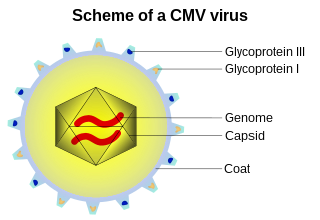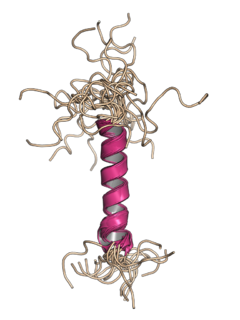Related Research Articles

A capsid is the protein shell of a virus, enclosing its genetic material. It consists of several oligomeric (repeating) structural subunits made of protein called protomers. The observable 3-dimensional morphological subunits, which may or may not correspond to individual proteins, are called capsomeres. The proteins making up the capsid are called capsid proteins or viral coat proteins (VCP). The capsid and inner genome is called the nucleocapsid.

Adeno-associated viruses (AAV) are small viruses that infect humans and some other primate species. They belong to the genus Dependoparvovirus, which in turn belongs to the family Parvoviridae. They are small replication-defective, nonenveloped viruses and have linear single-stranded DNA (ssDNA) genome of approximately 4.8 kilobases (kb).
HHV Latency Associated Transcript is a length of RNA which accumulates in cells hosting long-term, or latent, Human Herpes Virus (HHV) infections. The LAT RNA is produced by genetic transcription from a certain region of the viral DNA. LAT regulates the viral genome and interferes with the normal activities of the infected host cell.

Herpesviridae is a large family of DNA viruses that cause infections and certain diseases in animals, including humans. The members of this family are also known as herpesviruses. The family name is derived from the Greek word herpein, referring to spreading cutaneous lesions, usually involving blisters, seen in flares of herpes simplex 1, herpes simplex 2 and herpes zoster (shingles). In 1971, the International Committee on the Taxonomy of Viruses (ICTV) established Herpesvirus as a genus with 23 viruses among four groups. Currently, 107 species are recognized, all but one of which are in one of the three subfamilies.

Human Herpes Virus (HHV) Infected Cell Polypeptide 0 (ICP0) is a protein, encoded by the DNA of herpes viruses. It is produced by herpes viruses during the earliest stage of infection, when the virus has recently entered the host cell; this stage is known as the immediate-early or α ("alpha") phase of viral gene expression. During these early stages of infection, ICP0 protein is synthesized and transported to the nucleus of the infected host cell. Here, ICP0 promotes transcription from viral genes, disrupts structures in the nucleus known as nuclear dots or promyelocytic leukemia (PML) nuclear bodies, and alters the expression of host and viral genes in combination with a neuron specific protein. At later stages of cellular infection, ICP0 relocates to the cell cytoplasm to be incorporated into new virion particles.

Herpes simplex virus1 and 2, also known by their taxonomical names Human alphaherpesvirus 1 and Human alphaherpesvirus 2, are two members of the human Herpesviridae family, a set of new viruses that produce viral infections in the majority of humans. Both HSV-1 and HSV-2 are common and contagious. They can be spread when an infected person begins shedding the virus.
Macacine alphaherpesvirus 1, Herpesvirus simiae, or Herpes virus B) is the Simplexvirus infecting macaque monkeys. Macacine alphaherpesvirus 1 is an alphaherpesvirus, which consists of a subset of herpes viruses that travel within hosts using the peripheral nerves. As such, this neurotropic virus is not found in the blood.

Cyclic AMP-responsive element-binding protein 3 is a protein that in humans is encoded by the CREB3 gene.
Anthony (Tony) Charles Minson, PhD, FMedSci is a British virologist known for his work on the biology of herpesviruses, and a university administrator. He was the Senior Pro-Vice-Chancellor of the University of Cambridge from 2003 to 2009. He is emeritus professor of virology at the university's Department of Pathology and an emeritus fellow of Wolfson College.

The Herpesvirales is an order of dsDNA viruses with animal hosts, characterised by a common morphology consisting of an icosahedral capsid enclosed in a glycoprotein-containing lipid envelope. Common infections in humans caused by members of this order include cold sores, genital herpes, chickenpox, shingles, and glandular fever. Herpesvirales is the sole order in the class Herviviricetes, which is the sole class in the phylum Peploviricota.

Herpesvirus glycoprotein B is a viral glycoprotein that is involved in the viral cell entry of Herpes simplex virus (HSV). Herpesviruses have an envelope and an outer lipid bilayer which contains twelve surface glycoproteins. For infectivity to be attained, the double stranded DNA genome of HSV must enter the host cell through means of fusion of its envelope with the cellular membrane or via endocytosis. Other viral glycoproteins involved in the process of viral cell entry include gC, gB, gD, gH, and gL, but only gC, gB, gD, and gH are required for the fusion of the HSV's envelope with the cellular membrane. It can be noted that all herpesviruses have glycoproteins gB, gH, and gL.
ICP8, the herpes simplex virus type-1 single-strand DNA-binding protein, is one of seven proteins encoded in the viral genome of HSV-1 that is required for HSV-1 DNA replication. It is able to anneal to single-stranded DNA (ssDNA) as well as melt small fragments of double-stranded DNA (dsDNA); its role is to destabilize duplex DNA during initiation of replication. It differs from helicases because it is ATP- and Mg2+-independent. In cells infected with HSV-1, the DNA in those cells become colocalized with ICP8.

Major capsid protein VP1 is a viral protein that is the main component of the polyomavirus capsid. VP1 monomers are generally around 350 amino acids long and are capable of self-assembly into an icosahedral structure consisting of 360 VP1 molecules organized into 72 pentamers. VP1 molecules possess a surface binding site that interacts with sialic acids attached to glycans, including some gangliosides, on the surfaces of cells to initiate the process of viral infection. The VP1 protein, along with capsid components VP2 and VP3, is expressed from the "late region" of the circular viral genome.
David M. Knipe is the Higgins Professor of Microbiology and Molecular Genetics and interim Co-Chair in the Department of Microbiology and Immunobiology at the Harvard Medical School in Boston, Massachusetts and co-chief editor of the reference book Fields Virology. He had previously served as Chair of the Program in Virology at Harvard Medical School from 2004 through 2016.
Infected cell protein 47 also ICP-47 or ICP47 is a protein encoded by the viruses such as Herpes simplex virus and Cytomegalovirus that allows them to evade the human immune system's CD8 T-cell response by interfering with an infected cell's ability to show viral epitopes to T cells. Its secondary structure shows three helices.

Agnoprotein is a protein expressed by some members of the polyomavirus family from a gene called the agnogene. Polyomaviruses in which it occurs include two human polyomaviruses associated with disease, BK virus and JC virus, as well as the simian polyomavirus SV40.
Minor capsid protein VP2 and minor capsid protein VP3 are viral proteins that are components of the polyomavirus capsid. Polyomavirus capsids are composed of three proteins; the major component is major capsid protein VP1, which self-assembles into pentamers that in turn self-assemble into enclosed icosahedral structures. The minor components are VP2 and VP3, which bind in the interior of the capsid.
HSV epigenetics is the epigenetic modification of herpes simplex virus (HSV) genetic code.
Patricia Gail Spear is an American virologist. She is a professor emeritus of microbiology and immunology at Northwestern University in Evanston, Illinois. She is best known for her pioneering work studying the herpes simplex virus. Spear is a past president of the American Society for Virology and an elected member of the National Academy of Sciences.

Duplodnaviria is a realm of viruses that includes all double-stranded DNA viruses that encode the HK97-fold major capsid protein. The HK97-fold major capsid protein (HK97-MCP) is the primary component of the viral capsid, which stores the viral deoxyribonucleic acid (DNA). Viruses in the realm also share a number of other characteristics, such as an icosahedral capsid, an opening in the viral capsid called a portal, a protease enzyme that empties the inside of the capsid prior to DNA packaging, and a terminase enzyme that packages viral DNA into the capsid.
References
- 1 2 Cardone G, Winkler DC, Trus BL, Cheng N, Heuser JE, Newcomb WW, Brown JC, Steven AC (2007-05-10). "Visualization of the herpes simplex virus portal in situ by cryo-electron tomography". Virology. 361 (2): 426–34. doi:10.1016/j.virol.2006.10.047. PMC 1930166 . PMID 17188319.
- 1 2 3 Trus BL, Cheng N, Newcomb WW, Homa FL, Brown JC, Steven AC (November 2004). "Structure and polymorphism of the UL6 portal protein of herpes simplex virus type 1". Journal of Virology. 78 (22): 12668–71. doi:10.1128/JVI.78.22.12668-12671.2004. PMC 525097 . PMID 15507654.(Article: )
- 1 2 3 4 5 Nellissery JK, Szczepaniak R, Lamberti C, Weller SK (2007-06-20). "A putative leucine zipper within the HSV-1 UL6 protein is required for portal ring formation". Journal of Virology. 81 (17): 8868–77. doi:10.1128/JVI.00739-07. PMC 1951442 . PMID 17581990.
- 1 2 Newcomb WW, Homa FL, Brown JC (August 2005). "Involvement of the portal at an early step in herpes simplex virus capsid assembly". Journal of Virology. 79 (16): 10540–6. doi:10.1128/JVI.79.16.10540-10546.2005. PMC 1182615 . PMID 16051846.
- 1 2 Newcomb WW, Thomsen DR, Homa FL, Brown JC (September 2003). "Assembly of the herpes simplex virus capsid: identification of soluble scaffold-portal complexes and their role in formation of portal-containing capsids". Journal of Virology. 77 (18): 9862–71. doi:10.1128/JVI.77.18.9862-9871.2003. PMC 224603 . PMID 12941896. (Article: )
- 1 2 3 Singer GP, Newcomb WW, Thomsen DR, Homa FL, Brown JC (2005). "Identification of a region in the herpes simplex virus scaffolding protein required for interaction with the portal". Journal of Virology. 79 (1): 132–9. doi:10.1128/JVI.79.1.132-139.2005. PMC 538710 . PMID 15596809.
- 1 2 3 White CA, Stow ND, Patel AH, Hughes M, Preston VG (June 2003). "Herpes Simplex Virus Type 1 Portal Protein UL6 Interacts with the Putative Terminase Subunits UL15 and UL28". Journal of Virology. 77 (11): 6351–8. doi:10.1128/JVI.77.11.6351-6358.2003. PMC 154995 . PMID 12743292.
- 1 2 Newcomb WW, Booy FP, Brown JC (2007-05-13). "Uncoating the Herpes Simplex Virus Genome". Journal of Molecular Biology. 370 (4): 633–42. doi:10.1016/j.jmb.2007.05.023. PMC 1975772 . PMID 17540405.
- ↑ Herpesvirus UL6 like Conserved Domains view at NCBI
- ↑ Marja van Zeijl; Jeanette Fairhurst; Thomas R. Jones; Steven K. Vernon; John Morin; James LaRocque; Boris Feld; Bryan O'Hara; Jonathan D. Bloom; Stephen V. Johann (October 2000). "Novel Class of Thiourea Compounds That Inhibit Herpes Simplex Virus Type 1 DNA Cleavage and Encapsidation: Resistance Maps to the UL6 Gene". Journal of Virology. 74 (19): 9054–9061. doi:10.1128/JVI.74.19.9054-9061.2000. PMC 102102 . PMID 10982350.
- ↑ HSV-1 UL-6 amino acid sequence at NCBI